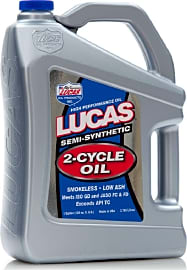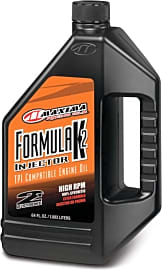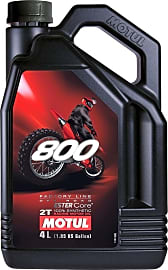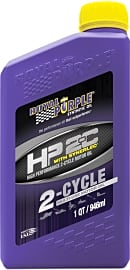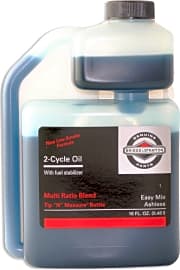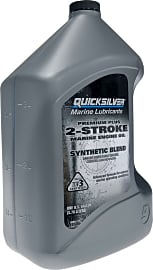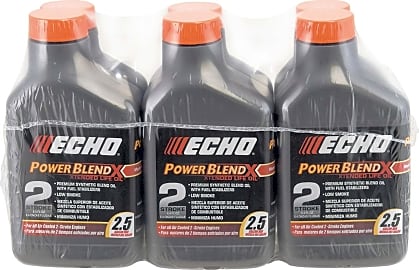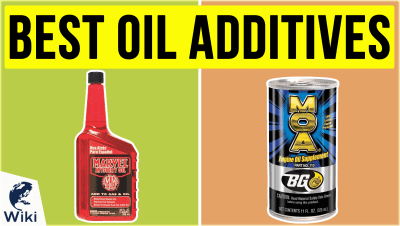The 10 Best 2-Stroke Engine Oils

This wiki has been updated 34 times since it was first published in June of 2016. Keep your lawn equipment, motorcycle, watercraft, or ATV running smoothly with one of these 2-stroke engine oils. Available in synthetic, semi-synthetic, and mineral, they can minimize spark plug fouling and carbon buildup, so your 2-cycle motor runs cleaner. From budget-friendly varieties to high-performance racing formulations, you'll find every type represented here. When users buy our independently chosen editorial recommendations, we may earn commissions to help fund the Wiki.
Editor's Notes
November 11, 2020:
To the uninitiated, all motor oils may seem to be exactly the same, but this couldn't be further from the truth. To start with, you have to choose the right kind for your engine type, which means getting 4-stroke oil for 4-stroke engines and 2-stroke oil for 2-stroke engines. While the composition of the two differs in a variety of ways, the most important thing to understand is that 2-stroke oils must be able to mix with fuel well and burn with it in the combustion chamber. The next thing to understand is that both oils come in come in synthetic, semi-synthetic, and conventional options. Calling any oil synthetic is actually a bit of a misnomer, as nearly all of them start with crude mineral oil, however it is extremely highly refined. As you probably guessed, semi-synthetics are less refined than full synthetics, but more so than conventional. The result of the refinement, and the various additives, is better and cleaner performance because the oil is more chemically stable and less likely to oxidize or breakdown. On this list we have included all three types.
Generally speaking, if not putting the oil into a high-performance engine, but rather lawn equipment and similar machinery, there is no real reason to spend the extra money on a full synthetic, so you can just stick with affordable options like Briggs & Stratton Easy Mix and Echo Power Blend Xtended, the former is conventional and the latter is a blend. If you are looking for something a bit higher-quality to run in an old dirt bike, ATV, or jet ski, Lucas Oil 10115 Semi-Synthetic is a suitable option, as it balances price and performance well.
These days, we are beginning to see 2-stroke engines that are fuel injected and if you have one of these, it is important that you get an oil that is compatible with this kind of system. On this update, we eliminated Maxima Formula K2 Premix in favor of Maxima Formula K2 Injector specifically because the latter works with tuned port injection systems, whereas the former doesn't. Other options on our list that are suitable for injection systems are Red Line Synthetic Racing, Pennzoil XLF, and Quicksilver 27Q01 Premium Plus.
For marine applications, it is important to use an oil specifically labeled for such a use, such as Pennzoil XLF and Quicksilver 27Q01 Premium Plus, because they are formulated for a higher level of corrosion protection.
September 02, 2019:
2-stroke engine oil varies wildly in price, and as with anything else, you get what you pay for. However, this doesn't mean you shouldn't automatically go out and buy the most expensive one. If looking for lubricant for a high-performance engine, such as a jet ski or finely-tuned racing vehicle, then buying a 100-percent synthetic or ester-based formula is a smart move, as it will help to preserve, and in some cases even boost, performance. However, if you are just trying to keep your string trimmer and lawn mower functioning reliably, you can easily save a few bucks and get a basic mineral-based oil or semi-synthetic blend.
For land-based racing applications and other high-performance engines, we recommend Red Line Racing, Maxima Formula K2, Ravenol Motocross Powersynth, Motul 800 2T, and Royal Purple HP 2-C. Of these, only Maxima Formula K2 and Motul 800 2T are ester based, but they all burn cleanly and will reduce carbon deposits. Another thing to note is that Maxima Formula K2, Royal Purple HP 2-C, and Motul 800 2T are only suitable for pre-mix applications, so don't buy any of these if you have an injection system in your vehicle.
For the boaters out there, we have included Pennzoil XLF and Quicksilver 27Q01 Premium Plus. While Quicksilver 27Q01 Premium Plus may eke out a win in the performance department, we feel that in the average casual boating application, it won't be noticeable enough to warrant the significantly more expensive price tag.
If you are simply looking for something for your outdoor power equipment, Briggs & Stratton Easy Mix and Echo Power Blend Xtended are reliable options that don't cost an arm and a leg.
Special Honors
Shell Advance Ultra 2 A fully synthetic formula designed specifically for motorcycles, Advance Ultra 2 can handle very high RPM for an extended period of time without resulting in carbon buildup. It is suitable for oil-injection and pre-mix systems and has an impressive film strength to prevent wear from metal-on-metal contact. shell.com
Two-Stroke Engines Versus Four-Stroke Engines
Each time the piston moves in a particular direction, it is called a stroke.
The term stroke refers to the movement of the piston. Each time the piston moves in a particular direction, it is called a stroke. Two-stroke engines are much simpler than their four-stroke counterparts. In a two-stroke engine, the piston moves two times per power cycle. One of these strokes is the compression stroke and the other is the combustion stroke. The reason a two-stroke engine only requires two strokes is because the combustion stroke and the beginning of the compression stroke happen simultaneously, along with the intake and exhaust functions. As the piston moves upwards to compress the current air-fuel mixture, it also exposes the intake port and draws a new air-fuel mixture into the crankcase below it at the same time. When the piston moves downwards during the combustion stroke, it opens the exhaust port, expelling the spent air-fuel mixture.
In a four-stroke engine, the piston moves four times for each power cycle. There is an intake stroke, followed by compression stroke, which is then followed by a combustion stroke, and finally an exhaust stroke. During the intake stroke, the intake valve opens up and the piston pulls in the air-fuel mixture as it moves from top dead center to bottom dead center. Once the piston hits bottom dead center, it reverses and moves upwards again, compressing the air-fuel mixture that was previously sucked into the cylinder. At this point, both the intake and exhaust valves are closed to create an air-tight seal. Once the piston hits top dead center again, the combustion stroke starts and the compressed air-fuel mixture is ignited with the aid of a spark plug (in the case of a gasoline engine) or by the heat produced during the compression stage (in the case of a diesel engine). The force of the combustion sends the piston back down to bottom dead center once again. It is at the point during the process that mechanical force is created to turn the crankshaft. After the piston hits bottom dead center, the exhaust valve opens, the piston reverses direction again, moving back towards top dead center and expelling the used air-fuel mixture.
Advantages And Disadvantages Of Two-Stroke Engines
Two-stroke engines have some considerable advantages over four-stroke engines that make them ideally suited to certain applications. They also have some notable disadvantages, as well. Their simplistic design and construction make them cheaper to manufacture and fix. They don't have any valves, instead making use of inlet and outlet ports, so there are less components that could potentially break. In two engines of the same size, two-strokes are capable of creating more power than four-strokes. This is because in a two-stroke engine, every other stroke is a combustion stroke. Combustion is when the engine's power is created. In a four-stroke engine, power is created once every four strokes.
They are less fuel efficient, since fuel gets consumed every other stroke.
Two-stroke engines don't require as heavy of a flywheel as four-stroke engines because they inherently run balanced. In a four-stroke engine, the crankshaft revolves twice for every one power stroke, which creates an imbalance. In a two-stroke engine, the crankshaft revolves once for every power stroke. Since two-stroke engines have fewer components and don't require such a heavy flywheel, they are lighter in weight than their four-stroke brethren. This makes the perfect for handheld applications, such as chainsaws and weed whackers. Their high power-to-weight ratio and lower cost also makes them ideal for recreational vehicles, like dirt bikes, ATVs, and outboard engines.
It isn't all roses when it comes to two-stroke engines, though. They are less fuel efficient, since fuel gets consumed every other stroke. Unconsumed fuel can also sometimes escape through the exhaust port. Two-stroke engines create more pollution, as well. This is because the combustion of oil produces more smoke than the combustion of fuel alone. Since two-stroke engines consume oil via combustion, users must add oil to their fuel tank every time they are refueling, which can get expensive.
Understanding The Three Main Types Of Two-Stroke Engine Oil
When it comes time to buy oil for your two-stroke engine, you may notice there are a few different types available, the most prominent of these being mineral, semi-synthetic, and synthetic. Each of these has different characteristics and the prices between them vary wildly.
They burn cleaner than any other type of engine oil, producing almost smokeless emissions.
Mineral oils are made from a base of natural petroleum oil. A complicated process of cleaning and filtration removes many of the contaminants, but it cannot remove all of them. The lowest cost mineral oils are usually derived from the poorest quality petroleum oil, which often contains many hard-to-remove contaminants that reduce its lubricating capabilities. To make up for this, most manufacturers mix a range of additives into it to help improve lubrication and combustibility. While you probably wouldn't want to use a mineral oil in your premium sports bike, it is more than adequate for older dirt bikes and garden tools.
Semi-synthetic oils are comprised of high quality mineral oils mixed with synthetic polymers that have superior lubricating qualities, along with other additives. The bulk of most semi-synthetic oils is mineral oil, with just a small volume of them being synthetic additives. This makes them cheaper than full synthetics, but cleaner and capable of better lubrication that standard low quality mineral oils. They are suitable for both high and low-end two-stroke engines.
Synthetic oils are also comprised of a base of mineral oil with additives, such as detergents, stabilizers, and octane enhancers, but they contain only the highest quality mineral oils. They also have a higher ratio of synthetic additives to natural oils. They burn cleaner than any other type of engine oil, producing almost smokeless emissions. Synthetic oils have better lubrication qualities than any other type of two-stroke engine oil, as well. While they are beneficial for every type of two-stroke engine, synthetic oils really shine in high-revving performance vehicles.


